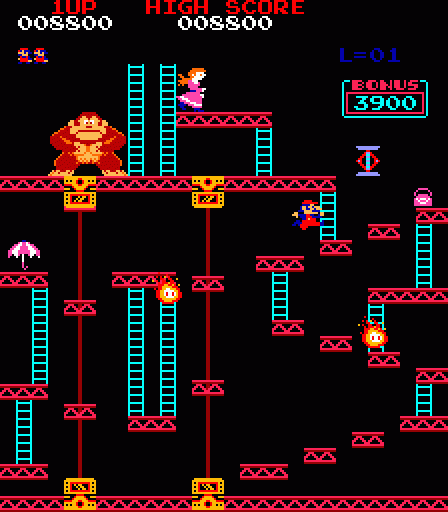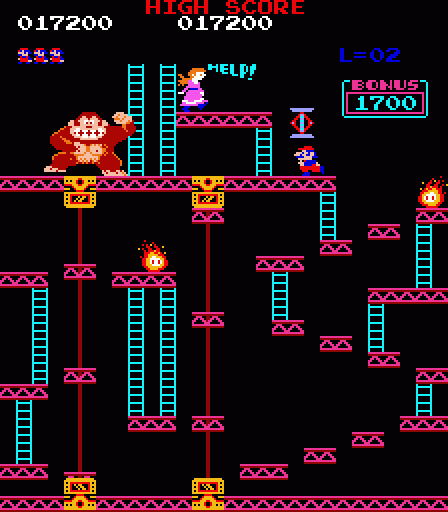Yes, I know Donkey Kong is a gorilla. Whatever.

If the cement factory stage represents Donkey Kong at its worst — and remember, “worst” in a game this well-designed simply means “OK but not amazing” — the lift level that follows it offers Donkey Kong at its best. While this screen may not offer an exquisitely crafted visual scenario on par with the opening stage, that’s only because the first screen bears the burden of teaching players the rules and goals of the game. This lift sequence builds on the knowledge engendered in the first stage and changes the rules, but it does so in a way that feels more focused than the cement factory.
While this stage comes third on the original Japanese arcade board and fourth on the U.S. boards, most home conversions treat this as the second stage — and rightly so! It’s a perfect elaboration of Donkey Kong’s rules, consistent with the opening screen’s rules and hazards while offering plenty of new things to consider and deal with.
As in the beginning level, Mario begins at the bottom left and has to make his way to the upper right in order to reach Pauline. Once again, Donkey Kong continues to pose a direct threat: This time he tosses spring jacks that bounce along the top girder before plummeting to the ground below. The jacks offer a more limited threat than the barrels — they follow a single path and can’t suddenly change direction — but they’re much, much faster. In fact, they’re the fastest object in the entire game. Their speed relative to everything else around them (including Mario) makes them intimidating, which can be unnerving enough to keep you from realizing that they always bounce in the exact same spots. It’s easy enough to stick to the apex of their bounce arc in order to keep Mario safe, but it’s also easy to become flustered by their brisk movement and lose your nerve.

Once you figure out the safe spot (as Mario has here), it’s easy enough to make a break for it and climb the ladder to Pauline between jack bounces.
Of course, the real trick here is simply reaching the top. While Mario faces fewer active hazards in this stage than in the game’s first two screens, the passive threat represented by the level itself can be plenty to deal with. Mario’s forced to navigate this stage by jumping, and unlike the first two stages he has plenty of opportunities to discover the unfortunate jump physics of Donkey Kong: If he falls from a height greater than his own body, he dies instantly. Clearly this is something he worked hard to overcome through the years.
To further complicate the choppy, broken scenery, much of the stage is dominated by a pair of elevator lifts, one rising up and the other moving downward. These increase the stress considerably since they force players to time their jumps carefully — wait too long (or twitch too soon) and the lift will have moved out of alignment with solid ground and your leap will take you more than a head-height, much to your regret.
Dangerous as the lifts can be, the level design offers alternatives for the insecure. If you prefer, you can simply climb the ladders to the left of the first elevators. It’s slower than riding up, but once you reach the top you can use the lift as a stepping stone, leaping quickly to the elevator once it reaches your level and then off again with no real need to worry about its height. However, climbing comes with its own concomitant peril: The platforms and ladders wedged between the lifts are patrolled by a roaming fireball, and it loosely tracks Mario’s location. If you choose to climb, it’ll putter up the ladder alongside you… meaning that when you go to leap to the center platform, it’ll be right there waiting to scorch you. Thus it’s a trade-off: Speed enough to outrace the fireball, or slow and steady leaving yourself vulnerable to its hostile drift?
On the center platform, you can play it a couple of different ways. You can be brash and leap from the top level onto a descending platform and to the topmost platform opposite — an incredibly tricky feat given that the opposite platform is slightly higher than your starting point, so you have to know the limits of Mario’s jump to a pixel. Or you can either hop onto a lift and ride it down to the bottommost platform or simply climb down a ladder and meet the lift at the bottom. If you go the top route, you bypass a huge chunk of the stage and rack up bonus points for your efficient use of time. Well done.
But if not, you have to navigate another route that once again offers a couple of different options. You can ascend the far right of the screen on nice safe ladders… but once again, this area is patrolled by a fireball that tends to drift in Mario’s direction. The other option is to leap your way up the platforms that bend to the left and then loop back around to the right. This poses a double hazard, though: Not only do you have to deal with the early days’ limitations of Mario’s jump, the left route also passes through the course that the spring jacks take as they plummet.
All in all, a fantastic level. Fast paced, throwing out tons of things for the player to cope with and keep track of, but never overwhelming. You’re given multiple choices to reach your goal at every turn, and the hazards comprise a mix of very carefully defined patterns and quirky randomness. Every pixel is plotted to exquisite perfection.
The ColecoVision version didn’t even have the springs in the elevator stage, which made it kind of pointless. Still don’t understand what people saw in that version of the game…
I played Super Mario Bros. long before Donkey Kong, and seeing the image of the first level of DK on some of those posters that would be included with the games led me to think that this would be a snap: Dash to the right, jump up, dash to the left, and repeat, no problem! After all, it’s Mario, right?
You can just imagine the rudeness of the awakening I was in for when I finally got to play.
Gorillas ARE apes 😉
Always hated this stage if only because Mario’s jump physics in Donkey Kong were somewhat unintuitive. You’d jump onto one of the elevators in what looked like a perfectly fine jump, and then die. They could have stood to give him a *bit* more leeway in fall distance IMO (but then, it’s an arcade game and meant to eat quarters, so I suppose understandable).
I probably didn’t help that most of my play was actually with the Commodore 64 version of the game which amazingly has the Cement Factory but omits *this* stage. I swear it might be the only home port that does that 😛